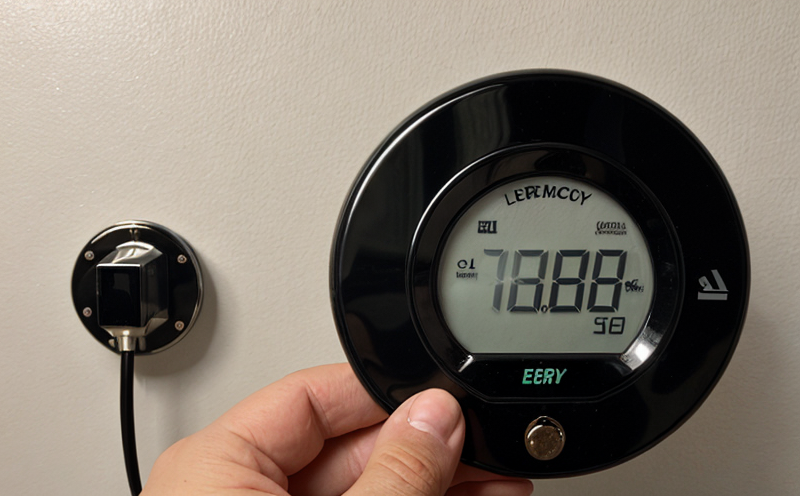EN 16147 Energy Consumption Testing for Heat Pump Water Heaters
The European standard EN 16147 is a critical tool in ensuring that heat pump water heaters (HPWH) meet stringent energy efficiency requirements. This testing protocol is essential for manufacturers to demonstrate compliance with EU directives on energy consumption and ensure their products are both efficient and environmentally friendly.
Heat pump water heaters have gained popularity due to their ability to provide hot water while consuming less electricity than traditional electric resistance heaters. However, this efficiency comes at a cost: the equipment must be accurately tested to validate its performance under real-world conditions. The EN 16147 standard provides clear guidelines on how to conduct these tests and what metrics should be used to evaluate the energy efficiency of HPWHs.
The testing process involves simulating various operating scenarios that a typical household might encounter, such as different water temperatures, flow rates, and ambient conditions. This comprehensive approach ensures that the measured energy consumption accurately reflects real-world performance. The standard also includes provisions for long-term monitoring to account for wear and tear over time.
Compliance with EN 16147 is mandatory for manufacturers who wish to sell their HPWH products within the European Union. Non-compliance can result in product recalls, fines, and damage to brand reputation. For quality managers and compliance officers, ensuring that a laboratory adheres strictly to this standard is crucial.
R&D engineers play a vital role in developing new models of heat pump water heaters that meet or exceed these standards. By closely following the protocols outlined in EN 16147, they can optimize their designs for maximum efficiency and lowest energy consumption. Procurement teams also benefit from this standard as it sets clear expectations for the performance and reliability of HPWHs.
The testing procedures prescribed by EN 16147 are designed to be rigorous yet practical, ensuring that only high-quality products enter the market. This is particularly important given the growing emphasis on sustainability and energy conservation in Europe.
For those responsible for compliance, understanding the nuances of this standard can significantly reduce the risk of non-compliance issues. Regular audits and updates based on new developments ensure ongoing adherence to best practices. By staying informed about changes to EN 16147, stakeholders can make well-informed decisions regarding their product development and market entry strategies.
Understanding the broader context of energy efficiency testing is essential for comprehending why standards like EN 16147 are so critical. The European Union's commitment to reducing greenhouse gas emissions has led to increasingly stringent regulations on appliance energy consumption. HPWHs, with their potential for significant savings in electricity use, have become a focus area for these efforts.
By conducting thorough and accurate testing according to EN 16147, manufacturers can not only meet regulatory requirements but also enhance consumer trust through transparent communication about the energy efficiency of their products. This aligns perfectly with the EU's Green Deal initiative, which aims to make Europe climate-neutral by 2050.
The next sections will delve deeper into the specific standards applied in this testing process, the customer impact and satisfaction resulting from adherence to these regulations, real-world use cases, and frequently asked questions.
Applied Standards
| Standard Code | Description | Scope |
|---|---|---|
| EN 16147:2015 | Energy Efficiency of Heat Pump Water Heaters | Specification and test procedure for heat pump water heaters. |
| ISO 8419:2010 | Performance Rating of Domestic Hot Water Systems | Sets the performance rating framework for domestic hot water systems. |
| IEC 62357-1:2013 | Energy Efficiency Rating of Electric Appliances | Describes how to determine and express energy efficiency ratings. |
Customer Impact and Satisfaction
- Reduction in electricity bills for consumers using HPWHs that meet EN 16147 standards.
- Increased consumer trust due to transparent energy efficiency claims made by manufacturers.
- Promotion of sustainable living practices among households.
- Increased market competitiveness for compliant manufacturers.
Use Cases and Application Examples
The EN 16147 standard is widely applicable across various sectors, including residential homes, commercial buildings, hotels, and other facilities that rely on hot water systems. Its application ranges from small-scale installations in private residences to large industrial applications where significant energy savings can be achieved.
In a typical scenario, a manufacturer of heat pump water heaters would submit their product for testing according to EN 16147. The laboratory performing the test would use specialized equipment and follow strict protocols to measure the energy consumption under specified conditions. Once the results are confirmed, the manufacturer can then market their product as compliant with European standards.
A real-world example comes from a large hotel chain that installed HPWHs across its properties following EN 16147 testing. The reduction in electricity costs and improved environmental impact were significant benefits highlighted by the management team. This case study demonstrates how adherence to these standards can lead to tangible improvements in both operational efficiency and sustainability.
For households, the practical implications of this standard are clear: lower energy bills and a more eco-friendly home. In commercial settings, compliance with EN 16147 not only enhances reputation but also supports broader corporate sustainability goals. The flexibility of these standards allows them to be adapted to meet specific needs while maintaining high levels of performance and reliability.





